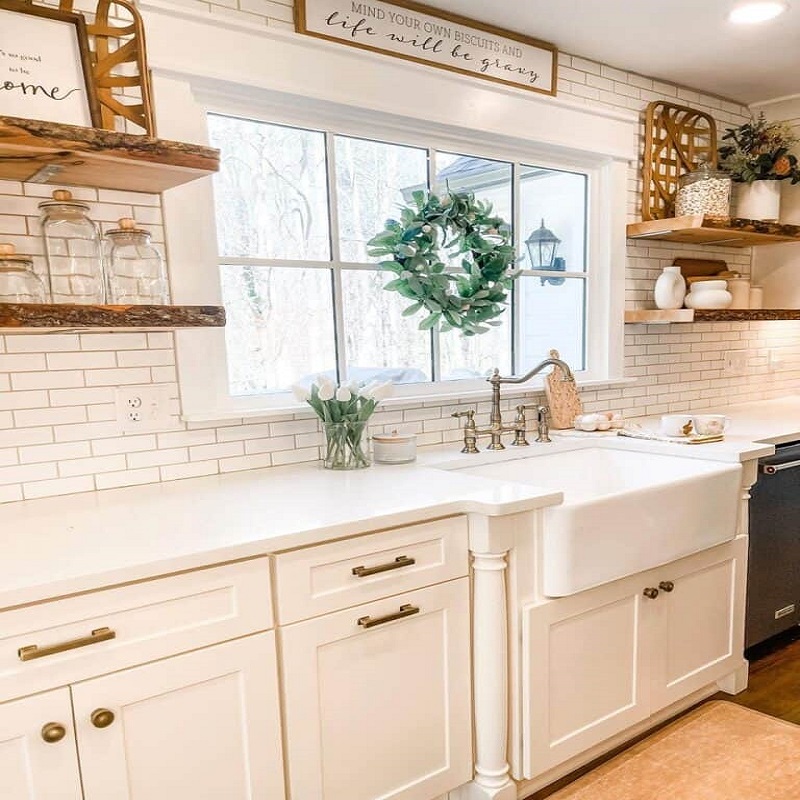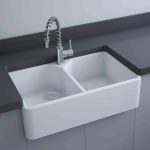A kitchen sink without a window can present a unique challenge when it comes to design and functionality. Without the natural light and outdoor views that a window provides, creating an inviting and efficient kitchen space requires some creative solutions. In this article, we’ll explore various strategies to enhance your kitchen sink area, from lighting and ventilation to design and decor. Let’s dive into these innovative approaches to make the most of a kitchen sink that lacks a window.
Maximizing Artificial Lighting
The Importance of Proper Lighting
In kitchens without windows, artificial lighting becomes crucial for both functionality and aesthetics. A well-lit kitchen sink area can enhance your cooking experience, improve safety, and make the space feel more open and inviting. Begin by assessing your current lighting situation and identify any gaps that need to be filled. The goal is to create a well-lit, functional workspace that reduces shadows and makes tasks like washing dishes easier.
Types of Lighting Solutions
- Overhead Lighting: Recessed ceiling lights or flush-mount fixtures provide general illumination and can be strategically placed to reduce shadows over the sink area. Consider dimmable options to adjust the brightness according to your needs.
- Under-Cabinet Lighting: Installing LED strip lights or puck lights under your cabinets can illuminate your countertops and sink area effectively. This type of lighting not only enhances visibility but also adds a modern touch to your kitchen.
- Task Lighting: Dedicated task lighting, such as adjustable pendant lights or gooseneck lamps, can focus light directly over the sink. This targeted illumination is particularly useful for detailed tasks like food preparation and washing dishes.
- Accent Lighting: To create a warm and inviting atmosphere, incorporate accent lighting such as under-sink LED strips or backlighting behind the faucet. Accent lighting adds depth and visual interest to the space.
By combining these lighting techniques, you can achieve a well-lit, functional kitchen sink area that compensates for the absence of natural light.
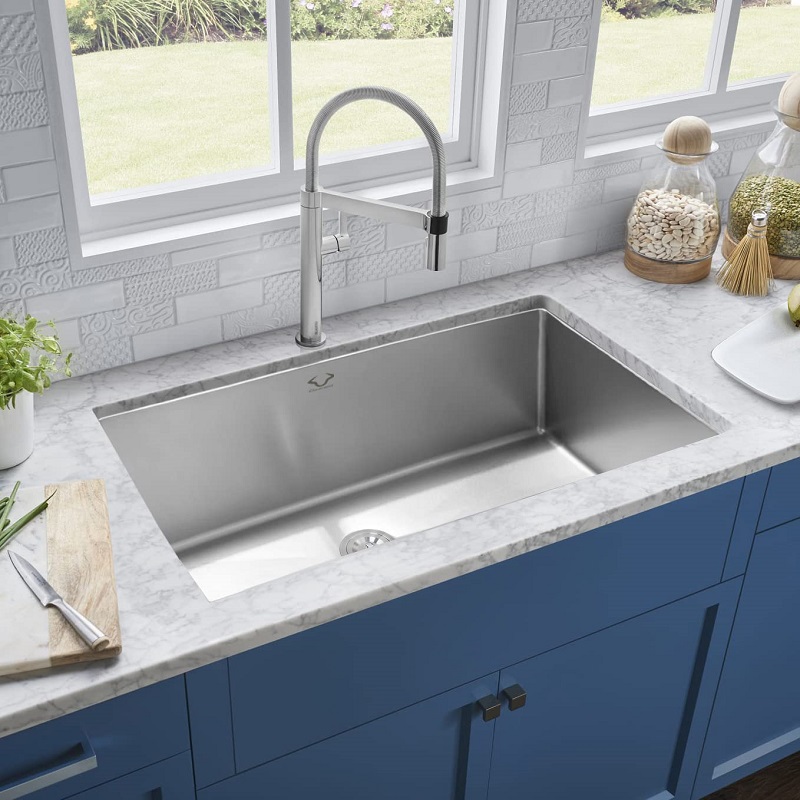
Enhancing Ventilation
The Need for Proper Ventilation
Proper ventilation is essential in any kitchen to remove cooking odors, steam, and moisture. In kitchens without windows, the challenge is to maintain good air quality and prevent the buildup of humidity and unpleasant smells. Effective ventilation solutions can help keep your kitchen fresh and comfortable.
Ventilation Solutions for Windowless Kitchens
- Range Hoods: A high-quality range hood installed above your stove will capture smoke, steam, and odors efficiently. Opt for models with powerful fans and filters to ensure effective air circulation. Choose between ducted range hoods, which vent air outside, or ductless models that use charcoal filters to recirculate clean air.
- Air Purifiers: An air purifier with a HEPA filter can help remove airborne particles and odors from the kitchen. Place it in a central location to maximize its effectiveness. Regularly clean or replace filters to maintain optimal performance.
- Ventilation Fans: Install a ventilation fan in the kitchen to improve air circulation and reduce humidity. Ceiling-mounted or wall-mounted fans can help move air around the room and prevent the accumulation of moisture.
- Dehumidifiers: In particularly humid environments, a dehumidifier can help control moisture levels and prevent mold growth. Choose a model that suits the size of your kitchen and ensure it is properly maintained.
By addressing ventilation needs with these solutions, you can create a healthier and more comfortable kitchen environment.
Creating a Functional Layout
Designing an Efficient Kitchen Sink Area
A well-designed kitchen sink area is crucial for maximizing efficiency and comfort. Without a window, it’s important to focus on layout and organization to make the space as functional as possible. Consider the following design strategies to optimize your sink area.
Layout Strategies for a Windowless Sink Area
- Work Triangle Concept: Arrange your sink, stove, and refrigerator to form a functional work triangle. This design principle ensures that all key work areas are within easy reach, minimizing the need to move around unnecessarily.
- Counter Space: Incorporate ample counter space around the sink to provide room for food preparation, washing dishes, and other tasks. Use counter extensions or additional shelving if space allows to enhance functionality.
- Storage Solutions: Maximize storage options with cabinets and drawers near the sink area. Consider installing pull-out racks or built-in organizers to keep cleaning supplies and kitchen tools within easy reach.
- Ergonomic Considerations: Choose a sink height that is comfortable for regular use. Consider an undermount sink design to provide a seamless counter-to-sink transition, making cleaning easier and more efficient.
By focusing on these design principles, you can create a kitchen sink area that is both functional and comfortable, even without the benefit of natural light.
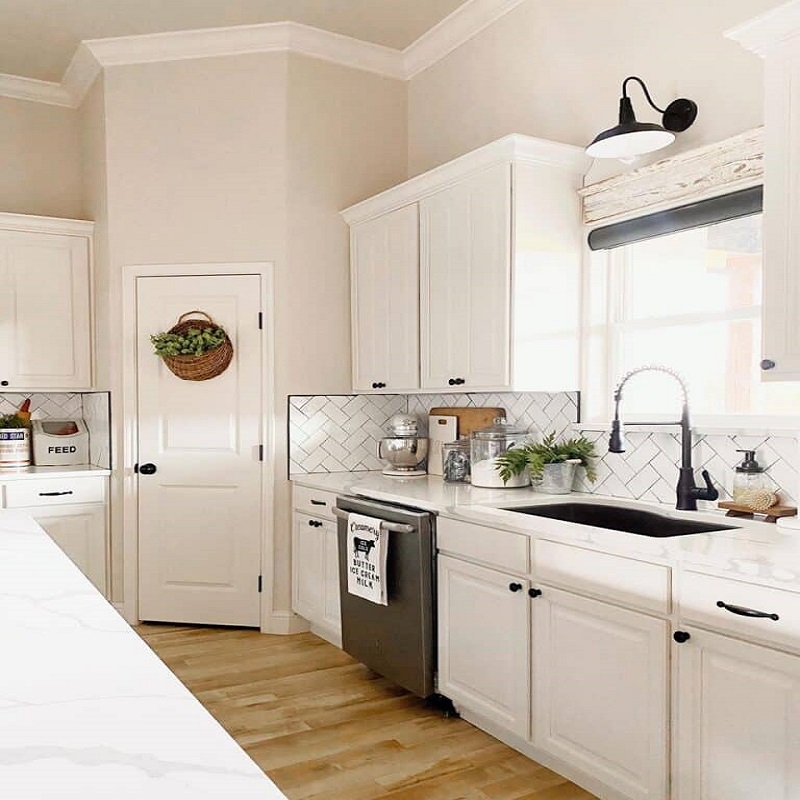
Incorporating Stylish Backsplashes
The Role of Backsplashes in Kitchen Design
A stylish backsplash can transform the appearance of your kitchen sink area, adding both visual interest and practicality. In a windowless kitchen, a backsplash can serve as a focal point and enhance the overall design of the space. Consider various backsplash materials and designs to complement your kitchen decor.
Backsplash Options for a Windowless Kitchen
- Tile Backsplashes: Ceramic, porcelain, or glass tiles offer a wide range of colors, patterns, and textures. Choose tiles that reflect light and brighten up the space. Subway tiles, mosaic patterns, or hexagonal designs can add visual appeal and dimension.
- Metal Backsplashes: Stainless steel or copper backsplashes can add a sleek, modern look to your kitchen. These materials are also easy to clean and maintain, making them practical for high-use areas.
- Stone Backsplashes: Natural stone options like granite, marble, or slate provide a luxurious and timeless appearance. Stone backsplashes can add texture and depth to your sink area, creating a sophisticated focal point.
- Glass Panels: Back-painted glass or acrylic panels offer a contemporary look and can be customized with various colors and finishes. Glass reflects light, helping to brighten up the kitchen and create a sense of openness.
By choosing the right backsplash, you can enhance the visual appeal of your windowless kitchen and create a stylish and functional sink area.
Utilizing Decorative Mirrors
The Benefits of Mirrors in Windowless Kitchens
Decorative mirrors can be a powerful tool for brightening up a windowless kitchen and creating the illusion of more space. By reflecting light and adding visual interest, mirrors can enhance the overall ambiance of the room. Consider incorporating mirrors strategically to maximize their impact.
Mirror Options for the Kitchen Sink Area
- Mirrored Backsplashes: Installing mirrored panels as a backsplash can help reflect light and make the kitchen appear larger. This option adds a modern touch and can be customized to fit your design preferences.
- Wall Mirrors: A large wall mirror above the sink area can create the illusion of depth and make the space feel more open. Choose a frame that complements your kitchen decor for a cohesive look.
- Decorative Mirror Accents: Smaller decorative mirrors or mirrored tiles can be used as accents around the sink area. These can add sparkle and interest without overwhelming the space.
- Mirrored Cabinets: Consider incorporating mirrored cabinet fronts or doors to enhance the reflective quality of the room. This design choice can add elegance and make the kitchen feel more expansive.
By thoughtfully integrating mirrors into your kitchen design, you can improve lighting, create a sense of space, and add a touch of sophistication to your windowless kitchen.
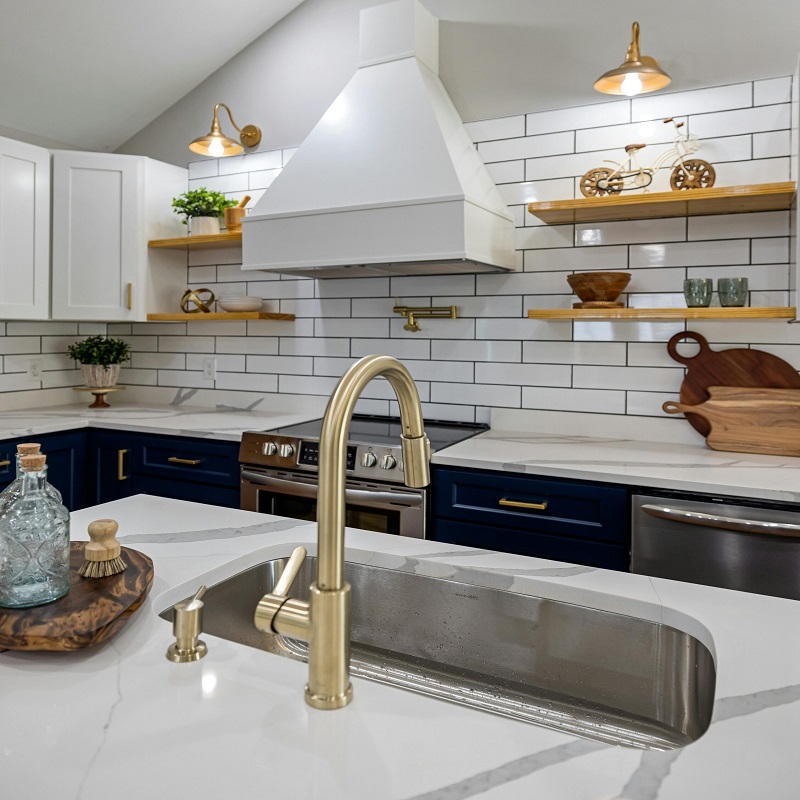
Incorporating Indoor Plants
The Benefits of Indoor Plants in a Windowless Kitchen
Indoor plants can bring a touch of nature to a kitchen without windows, enhancing the overall atmosphere and improving air quality. Selecting the right plants and placing them strategically can help create a more inviting and refreshing kitchen environment.
Best Indoor Plants for a Windowless Kitchen
- Low-Light Plants: Choose plants that thrive in low-light conditions, such as snake plants, pothos, or ZZ plants. These species are well-suited to environments with limited natural light and can add greenery to your kitchen.
- Herbs and Edible Plants: Consider growing herbs like basil, mint, or chives, which can be kept in small pots on your countertops or shelves. Edible plants not only add greenery but also provide fresh ingredients for cooking.
- Hanging Plants: Utilize hanging planters or wall-mounted shelves to display plants in your kitchen. This approach saves counter space and adds visual interest without cluttering the area.
- Artificial Plants: If natural light is a major concern, artificial plants can be a low-maintenance alternative. Choose high-quality faux plants that mimic the look of real greenery to achieve a similar aesthetic.
By incorporating indoor plants or their artificial counterparts, you can enhance the ambiance of your kitchen sink area and create a more pleasant and relaxing environment.
Enhancing Color and Texture
The Impact of Color and Texture on Windowless Kitchens
In a kitchen without windows, the choice of colors and textures can significantly impact the overall feel of the space. Using the right color palette and textures can make the kitchen feel brighter, more open, and more inviting. Consider these strategies to enhance the visual appeal of your sink area.
Color and Texture Solutions for a Windowless Kitchen
- Bright and Light Colors: Opt for light and neutral colors for walls, cabinetry, and countertops. Shades like white, cream, or light gray can help reflect artificial light and create a more open and airy feeling.
- Bold Accents: Introduce bold colors through accessories, such as towels, rugs, or cabinet hardware. These accents can add personality and contrast without overwhelming the space.
- Textured Finishes: Incorporate textured finishes such as matte, gloss, or textured tiles to add depth and interest. Textured surfaces can catch and reflect light, making the space feel more dynamic.
-
Glossy Surfaces: Choose glossy or high-shine finishes for cabinetry and countertops to reflect light and brighten the space. Gloss
